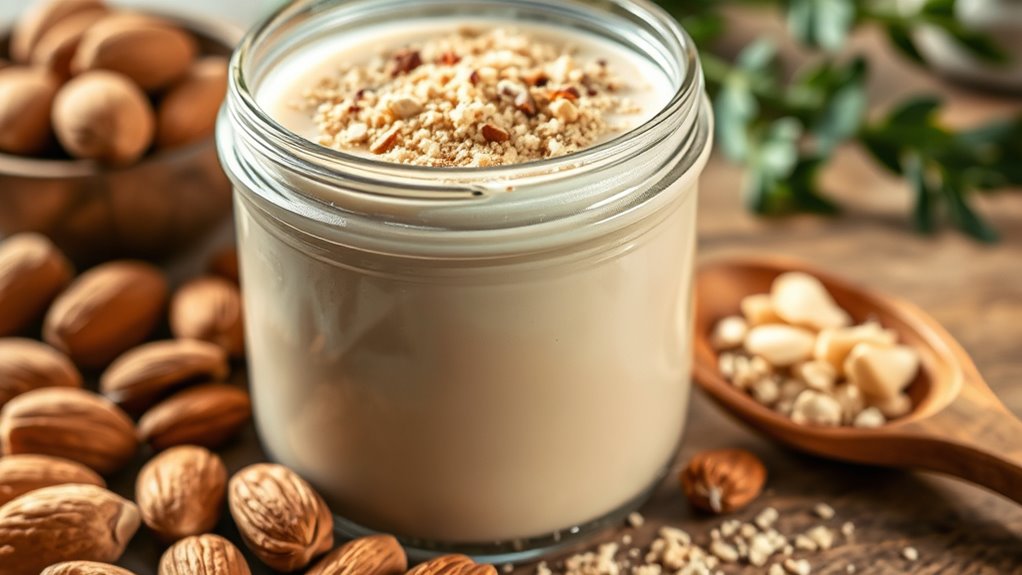To make creamier almond milk at home, soak raw almonds in water with a splash of lemon juice or apple cider vinegar for at least 12 hours to activate enzymes. When blending, add a pinch of salt or natural sweeteners to help break down the almonds further. Strain thoroughly to extract the milk, which will be smoother and more nutritious. If you want to discover more tips, keep exploring for additional secrets to perfect homemade almond milk.
Key Takeaways
- Soak almonds for at least 12 hours to activate natural enzymes that improve creaminess.
- Add a small amount of lemon juice or apple cider vinegar during blending to boost enzyme activity.
- Incorporate a pinch of salt or natural sweeteners to enhance flavor and aid digestion.
- Blend soaked almonds with water until smooth, then strain to extract creamy milk.
- Store in an airtight container and shake well before use to maintain optimal texture and freshness.

Making homemade almond milk is a simple and rewarding process that allows you to enjoy fresh, additive-free dairy alternatives whenever you want. When you start, the first step is almond harvesting, where you select ripe, healthy almonds. If you’re using raw almonds, verify they are properly dried and free of any mold or damage. Once you have your almonds, you’ll soak them in water for at least 12 hours or overnight. This soaking not only softens the nuts but also activates enzymes, making your almond milk creamier and easier to blend. After soaking, drain and rinse the almonds thoroughly.
Next, you’ll blend the soaked almonds with fresh water, typically in a ratio of 1 cup almonds to 3-4 cups water, depending on how thick or thin you prefer your milk. During blending, you can add a pinch of salt or a sweetener like dates or honey if desired. To boost enzyme activity, some recipes recommend adding a small amount of lemon juice or a splash of apple cider vinegar during blending. These acids help break down the almonds further, resulting in a richer, creamier texture. Once blended until smooth, you’ll strain the mixture through a nut milk bag, fine mesh strainer, or cheesecloth, squeezing out all the liquid. What remains is your fresh almond milk, which you can transfer to a clean jar or bottle for storage.
Regarding milk storage, it’s best to keep your homemade almond milk in an airtight container in the refrigerator. Use it within 3 to 4 days for maximum freshness, as homemade versions lack preservatives. Shake the container well before each use because the milk can separate naturally over time. To make the most of your almond pulp, consider drying and grinding it into almond flour or adding it to smoothies, baked goods, or oatmeal, reducing waste and enhancing flavor.
Additionally, selecting high-quality almonds ensures a better flavor and nutritional profile in your homemade milk. If you want to extend the shelf life, you can also freeze your almond milk in ice cube trays or small containers. Just be aware that freezing may slightly alter the texture, so give it a good shake after thawing. Throughout this process, paying attention to almond harvesting ensures you start with quality nuts, and proper milk storage guarantees you enjoy fresh, nutritious almond milk for several days. This simple method, combined with enzyme boosting steps, results in a creamier, more nutritious homemade almond milk that surpasses store-bought options in flavor and freshness.
Frequently Asked Questions
How Long Does Homemade Almond Milk Last Refrigerated?
You’re probably wondering how long homemade almond milk lasts when refrigerated. Typically, its storage duration is about 3 to 5 days, depending on how fresh your almonds are and how well you store it. The shelf life can vary, so always check for signs of spoilage like sour smell or curdling before using. To extend its freshness, keep it in a sealed container and give it a good shake before each use.
Can I Use Roasted Almonds for This Recipe?
You can use roasted almonds for this recipe, but keep in mind that almond roasting enhances flavor and adds a richer, nuttier taste. Roasting may also affect the texture slightly, making it creamier or more flavorful. Just make certain you let the almonds cool completely before blending. Using roasted almonds can give your homemade almond milk a deeper, more enhanced flavor, perfect for those who love a richer nutty taste.
What Are the Benefits of Enzyme Activation in Almond Milk?
You’re really onto something when exploring enzyme benefits, as they unleash more than just flavor—they boost nutritional enhancement too. Activating enzymes helps break down almond components, making nutrients more accessible and easier to digest. This process enhances the milk’s creaminess and overall health benefits. So, by incorporating enzymes, you’re killing two birds with one stone—improving texture while maximizing nutritional value in your homemade almond milk.
Is Homemade Almond Milk Suitable for Baking and Cooking?
Yes, homemade almond milk is versatile and works well in baking and cooking. Its natural flavor adds a nutty richness to recipes, and its baking compatibility makes it a great dairy alternative. You can use it in smoothies, sauces, or baked goods, benefiting from its creamy texture. Just guarantee it’s well strained and stored properly. Homemade almond milk enhances your dishes with a wholesome, plant-based touch.
How Can I Customize the Flavor of Almond Milk?
Did you know that adding flavor infusions can boost your almond milk’s appeal? You can customize the flavor by blending in vanilla, cocoa, or spices like cinnamon. Sweetening options like honey, maple syrup, or dates help tailor the sweetness to your taste. Experimenting with these methods allows you to create a personalized, flavorful almond milk perfect for coffee, cereal, or just sipping on its own.
Conclusion
Now that you’ve revealed the secret to enzyme-boosted almond milk, your homemade blend becomes a silky, nourishing elixir that dances on your taste buds like a gentle breeze. With each sip, you craft a creamy masterpiece that whispers purity and care. So, embrace this method, and let your kitchen transform into a sanctuary of wholesome magic, turning simple almonds into a luxurious, velvety delight that nourishes both your body and soul.









